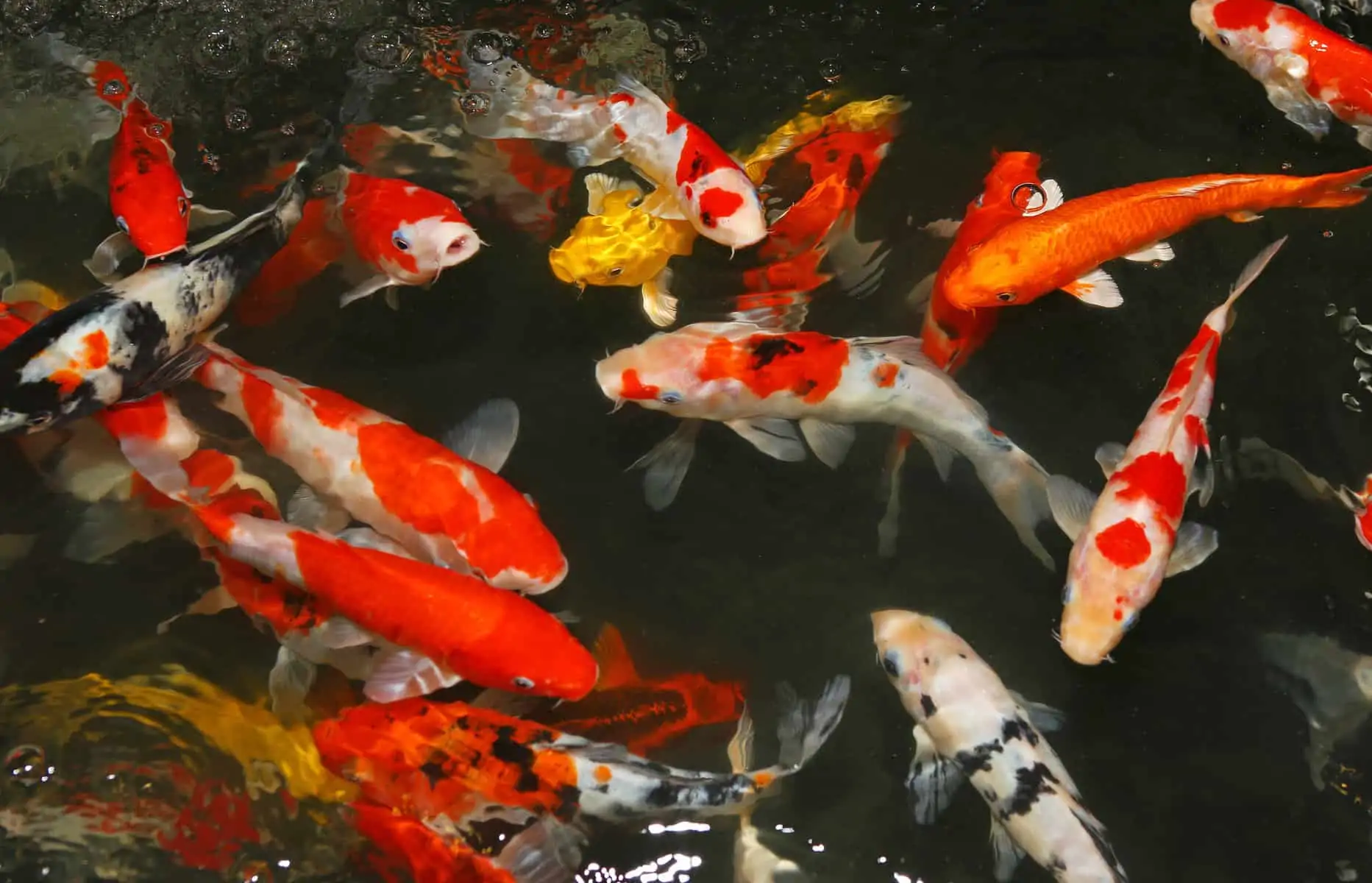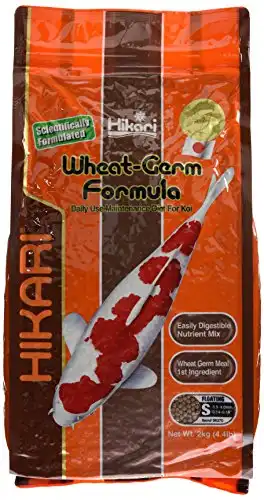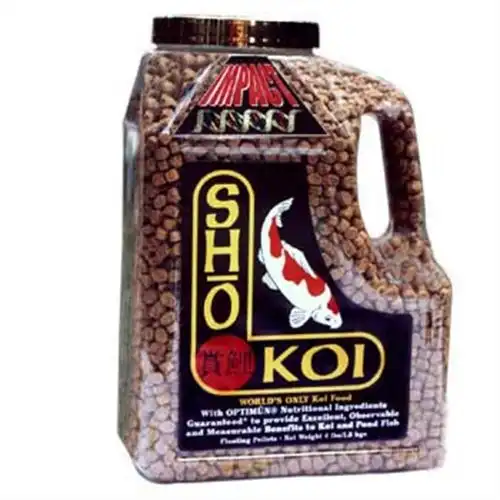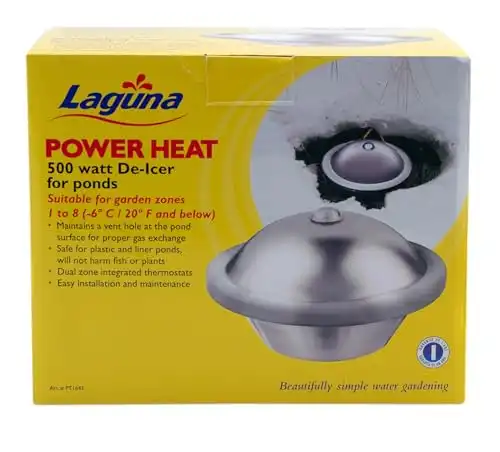[ad_1]
Koi fish are beautiful fish that have graced outdoor fish ponds for many years. Their glorious colors and patterns can turn heads, and the largest, most well-bred specimens can fetch very high prices.
Read this guide to learn everything you need to know about caring for the charming, charismatic Koi fish!
Koi Fish – At a Glance
| Koi Fish Info | |
|---|---|
| Scientific Name | Cyprinus rubrofuscus |
| Common Name (species) | Koi |
| Family | Cyprinidae |
| Origin | East Asia |
| Diet | Omnivorous (including pellets, fruits, and veggies) |
| Care Level | Intermediate |
| Lifespan | 25 to 35 years, although some can live longer than 50 years |
| Temperament | Generally peaceful |
| Minimum Tank Size | 1,000 gallons (outdoor pond recommended) |
| Temperature Range | 59 to 77°F (15 to 25°C) |
| pH Range | 7.0 to 8.6 |
| Water hardness | 5 to 19 dGH |
| Filtration/Flow Rate | High efficiency and volume, with good aeration |
| Water type | Freshwater |
| Breeding | Egg-layer; requires overwintering for breeding |
Key Takeaways
- Koi fish, a domesticated variety of the common carp, are popular ornamental pond fish known for their longevity, with potential lifespans of 25-35 years and some living for over 50 years.
- Proper care for Koi includes providing a spacious outdoor pond of at least 1,000 gallons, maintaining water parameters within specific ranges, and tailoring their diet to seasonal changes.
- Although hardy, Koi can succumb to various diseases; therefore, preventive care through quality nutrition, water maintenance, and stress minimization is crucial for their well-being.
Origins and Natural Habitat
The Koi fish, or Cyprinus carpio, is a domesticated form of the common carp and is native to Asia and Eastern Europe.
The name “Koi” is actually an abbreviation for “Nishikigoi,” which can be translated into English as “brocaded carp.” Koi fish are direct descendants of the common carp but, through selective breeding, are now classed as a species in their own right. They are not classed as aquarium fish but are ornamental pond fish; they are relatively hardy and live for many years, growing into large specimens as they mature.
It was in the 1820s that the carp were selectively bred for their coloration, and in the early 20th century, this practice became more and more widespread.
Wild Koi are freshwater fish that live in bodies of still water, including lakes, ponds, and rivers around the Black, Caspian, and Aral seas. These hardy fish thrive in temperate climates and can adapt to various water conditions.
Koi Fish Lifespan
Koi fish have a long lifespan, typically reaching between 25 and 35 years of age. However, some specimens have survived for over 50 years!
Appearance
Koi come in a wide variety of colors, including black, white, yellow, red, blue, orange, and cream. Combinations of these colors can create a truly stunning range of diverse, intricate patterns on the fish’s body and fins.
Koi fish have many different scale types, including matte, metallic, and reflective scales that help to emphasize their patterns and colors. Common patterns include white with red markings (Kohaku), black with red and white markings (Showa), and white with red and black markings (Taisho Sanke).
Like most carp species, Koi fish have an elongated, very streamlined body, which makes them agile, fast swimmers. Their fins are well-developed, and the tail can be round, forked, or butterfly-shaped.
Size
Koi can grow to an impressive size, often reaching over 3 feet in length! The fish’s size depends on various factors, including genetics, nutrition, and environmental conditions.
Koi Care Guide
If you have a large garden pond, now you know more about the species’ background, you’ll no doubt be keen to add a few of these gorgeous fish to your collection.
In this section of our guide, I explain how to care for these stunning fish.
First of all, I must stress that although Koi fish are pretty hardy, you must provide the fish with optimum water parameters, a well-maintained tank or pond, and a high-quality diet.
Tank Size
As mentioned earlier, the best home for Koi fish is a large outdoor pond of several thousand gallons.
These fish need plenty of space. Not only are they agile, fast swimmers, they can grow to a tremendous size.
Water Parameters
Koi fish are tolerant of various water conditions. They can happily survive outside during the winter months, provided you keep the pond clear of ice so that the fish can breathe and the water is well-oxygenated.
The water temperature should be in the range of 59 to 77°F (15 to 25°C), with a water pH of 7.0 to 8.6 and water hardness of 5 to 19 dGH.
Water Flow Rate
Koi appreciates plenty of water movement in the fish pond.
Often, you will see Koi ponds with slightly rounded corners. That’s to prevent dead spots and keep the water flowing freely. If you use a pond liner in your fish pond rather than cemented walls, then make sure that the corners are well tucked in and tidy, as these can also affect the water flow if they are irregular.
Substrate
Using substrate in your Koi pond is not necessary, although it’s always an option. Traditionally, many Koi breeders use mud as substrate, as it improves spawning conditions and allows the fish to dig around for food as they naturally would. The downside to this is that you won’t see your Koi much: the water can get very cloudy!
Decoration
Although Koi will eat almost any plant they find, you can still keep them in a planted pond by placing some plants, like marsh marigolds, at the edges or in your bog filter. That will give a beautiful effect and, most importantly, improve your water quality because plants will feed off nitrates in the water if the roots have access to the pond.
100 Marsh Marigold Native Wildflower Seeds
- First Quality Native Wildflower Seeds – Current Lab Test Data Shown on Packet
- Exclusive Gold Vault Packaging – Provides 3X Longer Storage than Paper or Plastic with Triple Layer Mylar Gold Foil.
- Resealable/Reusable Zipper Bag – Perfect for Storing Excess Seeds
Pond Mates
Slim-bodied goldfish, such as Shubunkins and Comets, make good pond mates for Koi fish, although I don’t recommend keeping fancy goldfish varieties in a Koi pond. Fancy goldfish are clumsy swimmers and can become stressed at feeding times, as the faster Koi will probably bump and buffet them. As a consequence, the goldfish could go hungry and even sustain injuries.
Orfe and Tench also do well in a Koi pond. However, it’s best to avoid shrimp, crayfish, and small fish, as these will most likely be viewed as a food source.
Diet and Nutrition
Feeding Koi can seem a bit daunting, but to simplify matters, their eating habits change throughout the year, and this is mostly dependent on the water temperature of the fish pond.
During fall, Koi should be fed wheat germ pellets that are high in carbohydrates and low in protein. Vegetable matter can also be supplied by offering them lettuce or even cabbage. During the winter months, Koi are largely inactive and will not require feeding, as they take what they need from the environment around them in the form of algae, small crustaceans, worms, and the like.
As the temperature increases in the spring, the water temperature will rise, and feedings should gradually be increased to at least once per day; the foods at this time of year should consist of Koi pellets that have a protein level of approximately 35%, varied with vegetables.
The temperature will continue to rise in the summer months, so the feeds should gradually increase until the fish are at their most active. The fish now require high-protein foods. Fresh vegetables and meaty foods, such as shrimp, can be offered in addition to pellets.
Often during the summer months, you might need to feed the fish three to four times per day. Koi can digest their food very quickly, hence the constant hunger. I have seen keepers throw a whole cabbage into the pond and the Koi carp attacking it like a shoal of Piranhas!
If the fish are fed correctly throughout the year, there should be no problems with them surviving the winter months, ready for the start of a new year. When using commercial Koi pellet food, always make sure that they are high quality and not expired.
Winter Care
Winter months are the most difficult time of the year for any pond fish, and allowing your pond to freeze over fully can cause problems.
If the pond is not deep enough, the Koi fish will have to tolerate water temperatures outside of their comfort zone and may even become trapped if the ice gets too thick. All Koi fish ponds should be at least 4 feet deep. That allows the fish to go to the bottom of the pond, where the temperature will be slightly higher than the upper levels. Be sure not to disturb the deeper layers of your pond during winter, as this will mix the warm and cold water and rob your fish of their safe place!
A full layer of ice over the pond for extended periods can trap toxic gases, which may affect the health of the fish. A pond de-icer is a good investment; this will not keep the whole pond ice-free, but it will leave one area open, allowing the gases to escape and oxygen to enter.
Temperament and Behavior
Koi are generally peaceful, active fish that must be kept in groups to create a harmonious, balanced society.
Health and Disease
Although they are a hardy species, Koi fish can be susceptible to some diseases and health issues.
Ich (Ichthyrphthirius multifiliis)
Ich is also known as Ick or White Spot disease and is caused by a protozoan parasite that causes a rash of tiny white cysts to infest the gills, skin, and fins of the fish.
This condition generally affects fish already weakened by disease or stress. Treat Ich by checking water parameters, keeping your pond clean and tidy, and using an over-the-counter medication you’ll get from your local fish store.
Spring Viremia of Carp (SVC)
SCV is a viral disease that attacks various carp species, including Koi, causing lethargy, skin lesions, and hemorrhages. This is a notifiable disease in many countries due to its impact on the carp industry.
Koi Herpesvirus (KHV)
KHV is a viral infection that can cause severe respiratory problems, skin lesions, and lethargy. This is a highly contagious disease with a very high mortality rate.
Columnaris Disease
Columnaris is a bacterial infection that affects the gills, fins, and skin of Koi fish. The condition is generally associated with stress and poor water quality.
Aeromonas and Pseudomonas Infections
Aeromonas and Pseudomonas are bacterial infections that can cause ulcers, skin lesions, and fin rot. Like many bacterial infections, these conditions usually attack weakened or stressed fish.
Parasites
Various internal and external parasites can attack Koi fish, including flukes, trichodina, and others. These pests can cause respiratory and other problems if not treated and eradicated.
Lymphocystis
Lymphocystis is another viral disease that causes tumors to grow on the fish’s fins and skin. Although this disease is not generally fatal, it can affect the health and appearance of the fish.
Dropsy
Dropsy is symptomatic of various underlying problems rather than being a disease in itself. The condition causes the fish’s body to swell and the scales to stick up, giving the creature the appearance of a pinecone.
Depending on the cause, Dropsy is often fatal since it can cause organ failure.
Disease Prevention
Prevention is much better than cure, and you can keep your fish healthy by maintaining good water quality, providing proper nutrition, and minimizing stress. Place any new fish or plants under observation in a quarantine pond or tank for a few weeks to keep parasites and bacteria at bay.
Breeding Koi Fish

Breeding Koi is pretty straightforward, provided you give your fish an optimal environment, select compatible breeding pairs, and provide developing fry with proper care.
Pond-kept Koi fish spawn naturally in the spring when the water temperature increases. Female Koi lay eggs that stick to submerged surfaces, and the male fish then fertilizes the eggs externally.
The fry hatch within two to five days, feeding initially from their yolk sac. After that, 100-micron-sized food powder should be sprinkled on the water’s surface three to five times a day for a week. As the fry grows, increase the food size so that by the time the fish are an inch long, they are eating 0.8 to 1.2mm medium crumb food.
Availability and Price
You can buy Koi fish from most good pond fish suppliers and breeders. The fish vary in cost, with more unusual patterns and colors fetching the highest prices. Mature specimens are generally more expensive than juveniles.
Prices range from around $50 per fish to hundreds and even thousands of dollars.
Final Thoughts
Koi fish are beautiful pond fish that can add a touch of glamour to your garden fish pond. These fish can grow to a massive 3 feet or more, so your pond must contain at least 1,000 gallons of water.
The fish are relatively easy to care for, although water conditions should be kept within ideal parameters, and the fish need extra attention during the winter months when the temperatures plummet.
Do you keep Koi? Tell us about your fish, and feel free to ask any questions you might have in the comments box below.
[ad_2]
Source link



